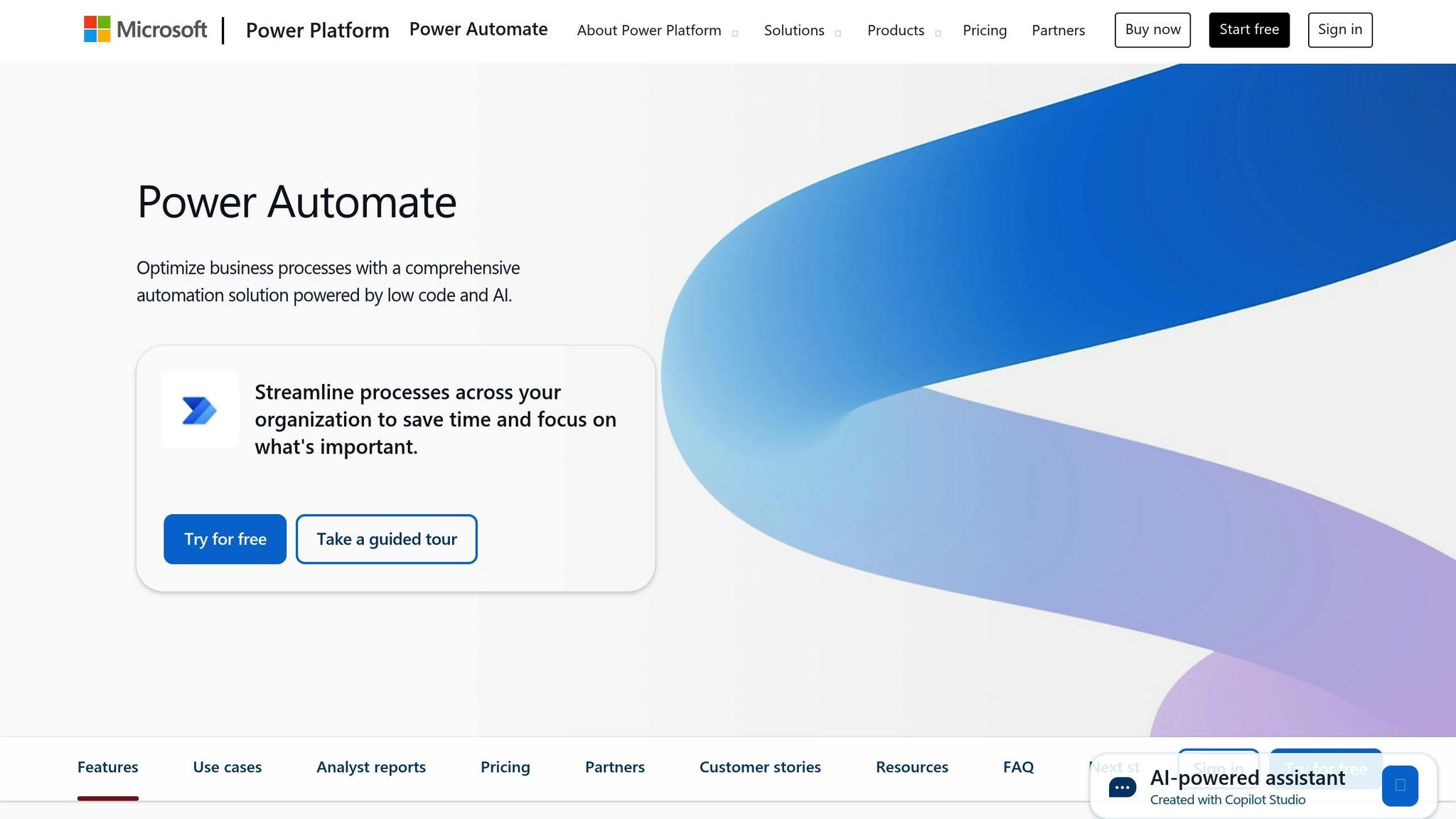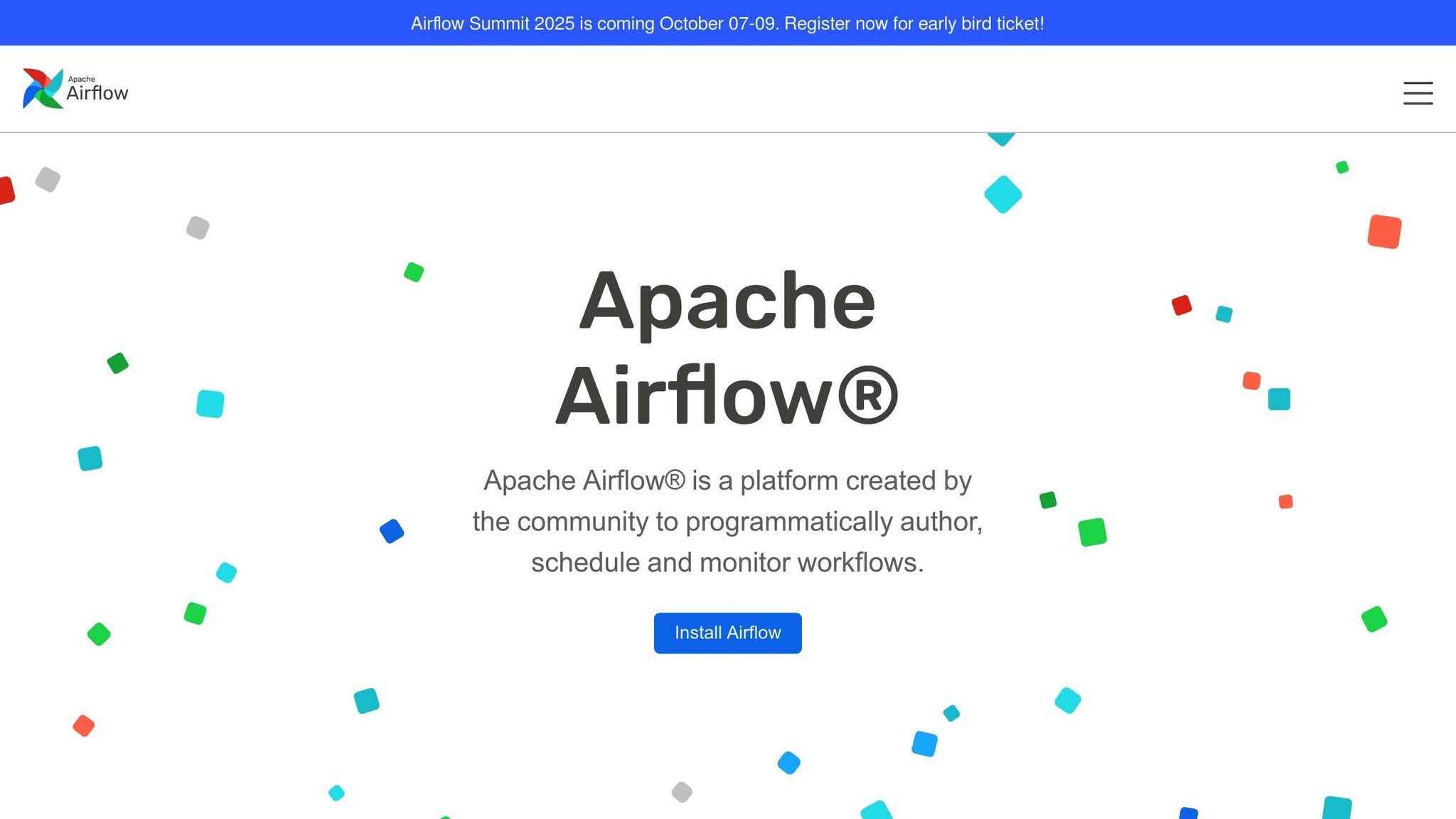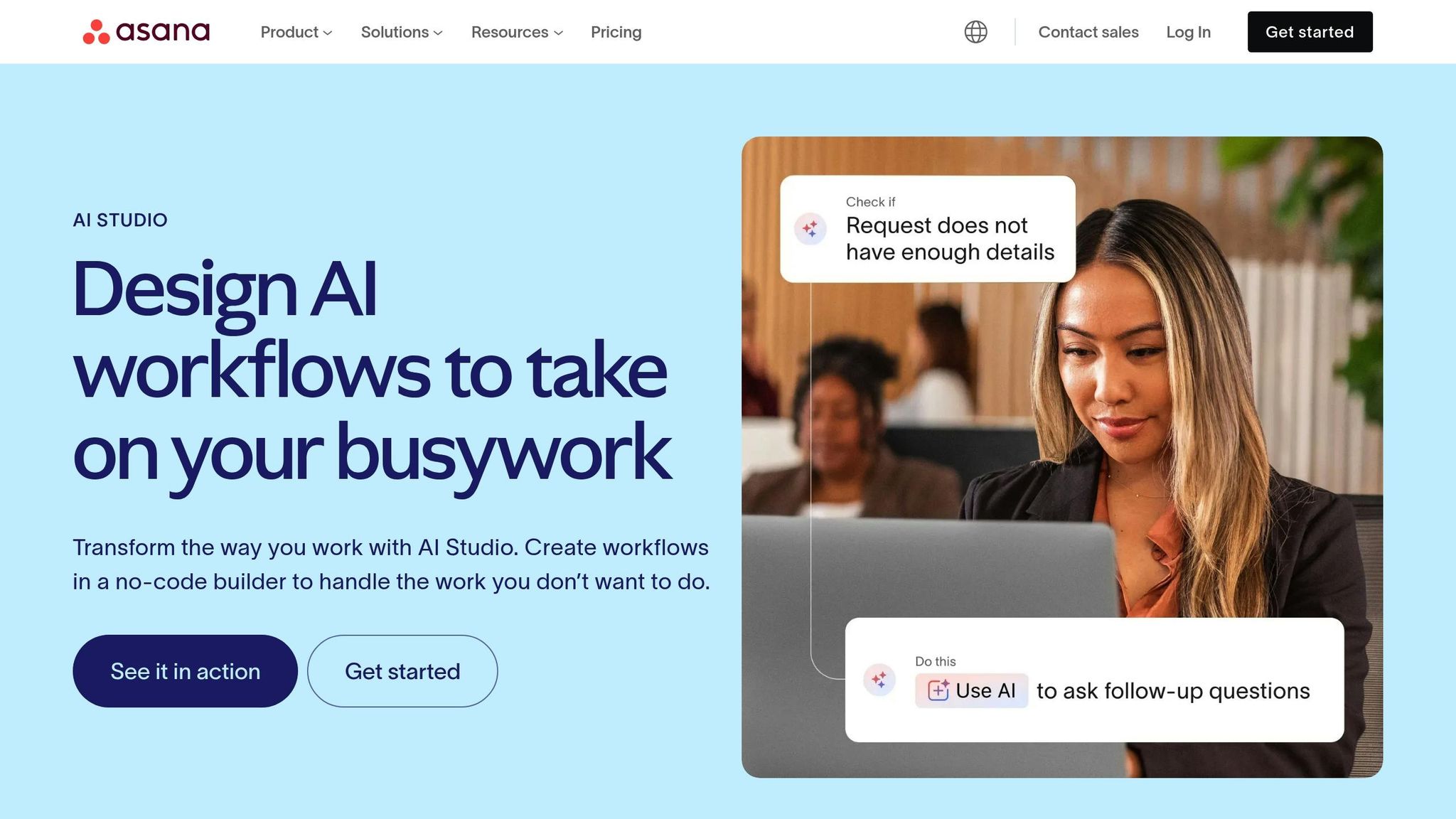
Across industries, AI is reshaping how businesses operate. From automating repetitive tasks to ensuring compliance, the right tools can save time, lower costs, and improve efficiency. Here’s a quick look at six enterprise-grade AI tools that stand out:
These tools tackle integration, automation, and governance challenges, ensuring businesses stay efficient, scalable, and compliant. Below, we break down their features, use cases, and pricing to help you choose the best fit for your needs.

Prompts.ai serves as a centralized platform that integrates multiple large language models into one secure, user-friendly interface. By unifying these models, it simplifies enterprise AI adoption and streamlines operations.
Prompts.ai seamlessly connects with everyday tools like Slack, Gmail, and Trello, enabling automated workflows that fit right into existing processes. This integration ensures smooth data flow and allows teams to access prebuilt workflows from any device, boosting productivity across the board. By bridging systems effectively, the platform lays a strong foundation for advanced task automation.
Prompts.ai transforms one-off tasks into scalable, repeatable processes. Users can automate routine work by deploying AI agents to handle repetitive tasks, freeing up valuable time. The platform also allows side-by-side comparisons of AI models, helping users choose the best tool for the job. These features have led to productivity gains of up to 10×, earning Prompts.ai recognition from GenAI.Works as a leading enterprise solution for automation and problem-solving.
The platform includes enterprise-grade governance tools that ensure compliance, particularly for regulated industries. Users have complete oversight of AI interactions across models, teams, and applications, promoting accountability and transparency. Its cloud-based design supports quick scaling, allowing companies to add new models, users, or teams in just minutes as their AI needs grow.
Prompts.ai helps enterprises cut AI expenses by up to 98% with its Pay-As-You-Go TOKN credit system, which ties costs directly to business outcomes. This eliminates the need for recurring subscription fees. Additionally, a built-in FinOps layer tracks credit usage in real time, ensuring budgets stay on track while maximizing the value of AI investments.

Moveworks is an AI-driven IT support platform designed to streamline and simplify IT service management by automating routine service requests. With its natural language processing capabilities, the platform understands employee queries and resolves common IT issues without human intervention. By integrating seamlessly with existing enterprise systems, Moveworks optimizes workflows and automates repetitive tasks, making it a valuable tool for improving efficiency and reducing operational costs.
Moveworks connects effortlessly with platforms like ServiceNow, Microsoft Teams, Slack, Okta, and Active Directory. Its API-first design ensures smooth integration into existing workflows, enabling enterprises to leverage their current tools while enhancing functionality.
The platform uses conversational AI to handle a variety of tasks, including resetting passwords, granting software access, troubleshooting network issues, and answering policy-related questions. Its machine learning capabilities continuously improve responses and identify new areas for automation, ensuring the system becomes smarter over time.
Moveworks' multi-tenant architecture is built to handle high volumes of interactions while maintaining individual conversation contexts. It also enables organizations to share insights across teams. IT leaders can implement approval workflows for sensitive actions, and the platform provides detailed analytics to help fine-tune processes, ensuring scalability without compromising control.
By automating routine IT requests, Moveworks significantly reduces help-desk workloads and associated costs. All actions are logged for compliance purposes, and the platform employs robust security measures, including multi-factor authentication, role-based access controls, and encrypted communications, ensuring it meets the highest security standards.

Microsoft Power Automate is a cloud-based service designed to automate repetitive tasks and simplify business processes. It allows organizations to build automated workflows that connect applications and services, making it easier to synchronize files, gather data, and send notifications. With its user-friendly visual designer and pre-built templates, Power Automate is accessible to both technical experts and non-technical users alike. What truly sets it apart is its seamless integration with various systems.
Power Automate excels in connecting diverse systems through its vast library of over 400 connectors. These connectors integrate Microsoft tools like Office 365, SharePoint, Teams, and Dynamics 365, as well as third-party platforms such as Salesforce, SAP, Oracle, and Google Workspace. This enables smooth workflows across departments and tools.
For companies relying on older or custom systems, the on-premises data gateway ensures secure connections to legacy platforms. Additionally, custom REST API connectors allow integration with specialized applications, making the platform versatile for different business needs.
The platform supports a range of automation options, including cloud flows, desktop flows, and guided business processes. Desktop flows, powered by robotic process automation (RPA), simulate human interactions with software, making it possible to automate tasks in systems without APIs.
Power Automate also incorporates AI Builder, which enhances automation through features like document processing and sentiment analysis. By leveraging AI, businesses can go beyond automating simple tasks to automating decision-making processes, allowing for more intelligent and scalable workflows.
Microsoft Power Automate is built to handle enterprise-level demands with advanced governance tools available in the Power Platform admin center. These tools help manage users, ensure compliance, and monitor activity. Data loss prevention (DLP) policies safeguard sensitive information by controlling how data flows between connectors, while environment management separates development, testing, and production workflows for better organization.
The platform automatically adjusts to varying workloads, ensuring reliability even during peak usage. Premium connectors enhance performance for critical processes, and the Center of Excellence (CoE) starter kits offer templates and best practices for implementing governance frameworks, helping businesses maintain control as automation scales across the organization.
Power Automate uses a flexible licensing model based on per-user or per-flow pricing. It includes built-in audit logging and holds certifications for compliance standards like SOC 1, SOC 2, ISO 27001, and HIPAA. Integration with Microsoft Purview further extends its data governance capabilities.
Features like run history and error handling provide visibility into workflow performance, making it easier to troubleshoot and optimize processes. Retention policies allow organizations to manage how long workflow data is stored, balancing operational needs with compliance requirements. By connecting enterprise systems with intelligent automation, Power Automate creates a unified and efficient ecosystem for businesses.

Apache Airflow is an open-source platform built to help users design, schedule, and manage intricate workflows programmatically. Unlike older workflow tools, Airflow uses Directed Acyclic Graphs (DAGs) written in Python, giving businesses the flexibility to tailor their data operations. Its open-source foundation makes it an excellent choice for enterprises seeking customizable and interoperable workflow automation. The platform is designed to integrate effortlessly with a wide range of enterprise tools and resources.
One of Airflow's standout features is its ability to connect with major cloud platforms and enterprise databases through pre-built operators and hooks. These integrations include AWS, Google Cloud Platform, Microsoft Azure, PostgreSQL, MySQL, Oracle, and MongoDB. This means teams can coordinate workflows across various systems without needing to write custom code for each integration.
Airflow's XCom (cross-communication) feature allows tasks within a workflow to share data, enabling seamless transitions between systems. For businesses operating in hybrid cloud environments, the KubernetesExecutor ensures workflows can run across both on-premises and cloud infrastructure. Additionally, enterprises can develop custom operators to link proprietary systems, ensuring even niche tools are part of the automation process.
Airflow simplifies the automation of complex workflows with dynamic DAGs that adapt to changing data and conditions. Task dependencies are clearly defined, ensuring processes run in the correct sequence. Built-in retry mechanisms and failure alerts further enhance reliability.
Sensor operators are particularly useful, as they monitor external systems for specific triggers, such as the arrival of a file or a database update. Branching operators add flexibility by enabling conditional execution based on prior task results. For machine learning applications, Airflow integrates with platforms like MLflow and Kubeflow, streamlining tasks like model training, validation, and deployment across different environments.
Airflow's architecture is designed to scale with enterprise needs. Its multi-node setup supports horizontal scaling, allowing workflows to run efficiently across multiple servers. Executors like Celery and Kubernetes help distribute tasks and dynamically allocate resources, ensuring optimal performance. Task parallelism settings further prevent resource overuse, maintaining system stability.
The platform also provides robust management tools. Through its web interface, users can access detailed audit logs and data lineage tracking, showing when tasks were executed, who initiated them, and the data involved. Role-based access control (RBAC) ensures that permissions are tightly managed at both the DAG and task levels. Additionally, SLA monitoring keeps teams informed when workflows exceed expected completion times, enabling quick action.
Airflow's open-source nature eliminates licensing fees, making it a cost-effective solution for enterprises. Features like resource pooling and task queuing help optimize resource usage during peak times, reducing operational costs. Centralized connection management further simplifies maintenance by consolidating credentials and configurations.
On the compliance front, Airflow supports regulatory requirements with detailed execution logs and data lineage tracking, which are invaluable during audits. Security is a top priority, with options for encrypting data both in transit and at rest. Integration with authentication systems such as LDAP and OAuth ensures secure user access, while backup and recovery features protect workflow definitions and execution histories. These capabilities enable businesses to maintain compliance, safeguard data, and streamline operations, all while managing workflows effectively across diverse environments.

Asana AI Studio transforms project management by automating routine tasks, predicting potential bottlenecks, and streamlining resource allocation with the help of machine learning and natural language processing. This advanced extension of Asana’s platform interprets project details to recommend workflow improvements, setting it apart from traditional project management tools. By leveraging AI, it not only automates mundane tasks but also optimizes team resources for better efficiency.
Asana AI Studio smoothly integrates with major enterprise applications through robust APIs, ensuring seamless data synchronization. Its compatibility with popular productivity and collaboration tools allows businesses to maintain their existing workflows, supported by custom field mapping to preserve internal processes.
The Smart Sync feature takes automation a step further by creating tasks, assigning team members based on predefined rules, and tracking milestones - eliminating the need for manual data entry.
Security is a key focus, with SSO and SCIM integration centralizing user management and securing data exchanges. Additional safeguards, such as API rate limiting and webhook security, ensure stable and secure operations even during high-volume activity. These capabilities enable intelligent automation while maintaining data integrity across projects.
With predictive analytics and machine learning, AI Studio analyzes historical data to optimize task sequences and assign work based on team capacity. By studying past project trends, the platform adjusts workflows dynamically, factoring in team performance, seasonal patterns, and resource availability.
The Smart Templates feature continuously refines task sequences, timelines, and resource assignments by learning from successful project outcomes. Meanwhile, Intelligent Task Assignment uses natural language processing to match tasks with team members who have the right skills and availability. For example, when a task like "Design user interface for mobile app" is created, the platform identifies the best-suited team member, taking into account their workload and deadlines.
Predictive Alerts provide real-time updates on project health, helping managers make timely adjustments. By analyzing metrics like team velocity, task complexity, and historical completion rates, these alerts allow for proactive resource reallocation or timeline adjustments before issues escalate. These features make AI Studio a scalable tool capable of meeting the demands of large enterprises.
Asana AI Studio is designed to handle the needs of large organizations with features like Portfolio Intelligence, which delivers real-time insights across departments. Advanced filtering and grouping options, combined with role-based permissions, ensure that sensitive project data remains secure and accessible only to authorized personnel.
Granular access controls allow for precise management of permissions across projects, tasks, and fields. Audit logs track user actions and system changes, providing transparency for compliance and security reviews. These governance tools ensure enterprises can scale operations without compromising on security or accountability.
AI Studio helps organizations cut costs by optimizing resource usage. Analytics pinpoint underutilized capacity and improve workload distribution, while automated time tracking and cost calculations offer accurate budget monitoring.
The platform’s Compliance Dashboard simplifies regulatory adherence by creating audit trails, enforcing data retention policies, and documenting decision-making processes. With built-in templates and automated reporting, it supports compliance with frameworks like GDPR and SOX.
Additionally, Intelligent Automation minimizes repetitive tasks by generating status reports, updating stakeholders, and rescheduling meetings as projects evolve. By reducing administrative burdens, teams can dedicate more time to strategic, high-impact work.

Diaflow is a platform designed to simplify enterprise workflow management by combining conversational AI with visual process automation. It allows users to create, edit, and execute workflows using plain language, removing the need for advanced technical expertise.
These key features make Diaflow a powerful tool for streamlining processes and automating tasks efficiently.
Diaflow includes a Universal API Gateway that connects effortlessly with a variety of enterprise tools, such as CRM, ERP, and productivity applications. With its smart connectors, the platform maps data fields to ensure smooth integration, preserving the value of existing systems while enhancing them with AI-driven automation. It also monitors systems in real time, triggering workflows and maintaining data accuracy through bidirectional synchronization.
The platform’s Contextual AI Engine learns from user interactions, continuously improving workflow suggestions. Its dynamic workflow builder adapts instantly to changing conditions, automatically adjusting tasks as needed. Users can also make workflow changes on the fly with simple natural language commands, making the system both intuitive and flexible.
To handle peak activity, Diaflow employs distributed processing for balanced workloads. It also prioritizes governance with features like role-based controls, detailed audit trails, and version management. These tools ensure workflows are managed securely and transparently, meeting both operational and compliance standards.
Diaflow is designed to maximize resource usage by analyzing workflow performance and identifying areas for improvement. Its automated compliance monitoring and pre-built templates for various regulatory standards help organizations stay aligned with legal requirements. Additionally, predictive cost modeling features guide smarter decision-making for automation investments, ensuring both cost savings and operational effectiveness.
Selecting the right AI tool for your enterprise workflow hinges on your unique needs, technical capabilities, and budget. The table below offers a quick side-by-side comparison, while the analysis that follows dives into key differences to help guide your decision.
| Tool | Key Strengths | Primary Use Cases | Pricing Model | Best For |
|---|---|---|---|---|
| Prompts.ai | Access to 35+ LLM models, up to 98% cost savings, enterprise-level governance | AI orchestration, prompt management, multi-model workflows | Pay-as-you-go TOKN credits, $99-$129/member/month | Teams looking for centralized AI management with cost efficiency |
| Moveworks | Natural language IT support, employee self-service automation | IT helpdesk automation, employee support workflows | Enterprise pricing (contact-based) | Large enterprises needing advanced IT support solutions |
| Microsoft Power Automate | Seamless integration with Microsoft's ecosystem, visual workflow builder | Document processing, approval workflows, data synchronization | $15-$40/user/month | Organizations heavily invested in Microsoft tools seeking automation |
| Apache Airflow | Open-source flexibility, ideal for complex data pipelines | Data engineering, ETL processes, scheduled batch jobs | Free (self-hosted) + infrastructure costs | Technical teams handling intricate data workflows |
| Asana AI Studio | Built-in project management, task automation for teams | Optimizing project workflows, enhancing team collaboration | $10.99-$24.99/user/month | Teams focused on project management and intelligent task handling |
| Diaflow | Conversational AI workflows, Universal API Gateway for integrations | Process automation, enterprise system integration | Custom enterprise pricing | Businesses requiring intuitive workflows with broad connectivity options |
Technical complexity varies widely across tools, making expertise a deciding factor. For example, Apache Airflow is best suited for teams with advanced technical skills, while Diaflow and Asana AI Studio cater to users with minimal technical backgrounds.
Integration capabilities also play a major role. Power Automate thrives within Microsoft's ecosystem, Prompts.ai excels at unifying multiple LLMs, and Diaflow offers broad connectivity through its Universal API Gateway.
When it comes to scalability, tools like Apache Airflow are ideal for handling large-scale data workflows, though they require significant setup. In contrast, Prompts.ai, Moveworks, and Diaflow offer distributed processing that simplifies scaling.
Cost structures differ significantly. Apache Airflow is free to use but comes with infrastructure expenses, while Prompts.ai offers a flexible pay-as-you-go model to help control costs. SaaS tools like Power Automate and Asana AI Studio provide predictable monthly pricing, though expenses can grow as teams expand.
For compliance, Prompts.ai and Diaflow stand out with features like audit trails and role-based access controls, which are critical for meeting regulatory requirements.
Ease of use is another factor. Tools like Power Automate offer user-friendly visual interfaces, while Apache Airflow requires more in-depth training. Prompts.ai strikes a balance by offering expert-designed workflows and certification programs to help teams quickly become proficient with AI tools.
Adopting the right AI tools can turn disorganized workflows into streamlined, efficient operations that deliver measurable results. Companies implementing these technologies often experience significant gains in productivity, cost savings, and faster decision-making.
To get the most out of your AI investment, opt for centralized platforms that unify AI operations while allowing flexibility. Managing multiple disconnected tools is inefficient - centralized solutions reduce the hassle of switching between systems, lower training demands, and provide complete oversight of AI activities.
Strong governance is critical. Ensure your tools support role-based access, audit trails, and transparent cost tracking to meet compliance standards and maintain budget control. These features are essential for scaling AI responsibly across your organization.
Integration with existing systems - whether it’s Microsoft platforms, custom workflows, or specialized software - is another key factor. Smooth integration minimizes setup challenges and accelerates the time it takes to see value from AI initiatives.
Cost efficiency is equally important. Choose solutions that offer real-time spending insights and flexible pricing models, enabling smarter, performance-driven decisions.
Integrating AI tools such as Prompts.ai can reshape how enterprises operate by taking over repetitive tasks, reducing human errors, and simplifying intricate processes. These improvements free up valuable time, enabling employees to concentrate on more strategic and impactful work, which ultimately boosts productivity.
AI-driven solutions also play a crucial role in improving decision-making. By delivering actionable, data-backed insights, they help businesses allocate resources more effectively. This leads to smoother operations, cuts down on wasteful spending, and supports high performance and scalability - all while keeping costs under control.
When choosing AI tools to automate workflows, it's essential to prioritize how well they integrate with your existing systems. The tools should work effortlessly with your current software and platforms to avoid disruptions. Look for solutions designed to tackle specific business challenges while delivering tangible benefits, such as boosting efficiency or cutting costs.
Focus on key factors like security, scalability, and user-friendliness. Tools offering low-code or no-code options can be especially valuable, as they simplify adoption across teams. Ensure the solution aligns with your organization's long-term objectives and delivers a strong return on investment (ROI). Selecting the right AI tool can streamline operations and enhance productivity while addressing your business's unique demands.
AI tools such as Moveworks and Diaflow emphasize safeguarding data and meeting compliance requirements through advanced strategies like encryption, strict access controls, and alignment with regulatory standards like FedRAMP and the NIST AI Risk Management Framework. These steps are designed to protect sensitive information and ensure its confidentiality.
Moveworks adopts a strong focus on security, achieving FedRAMP readiness, which makes it an ideal choice for government agencies and large enterprises. On the other hand, Diaflow streamlines secure data workflows by adhering to current privacy standards and evolving AI governance protocols, enabling businesses to deploy AI responsibly and in full compliance.


